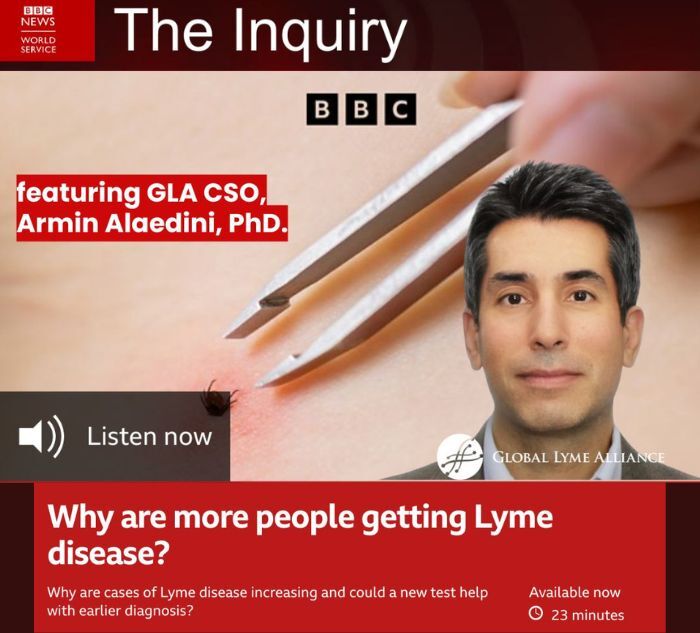.jpg)
What is brain fog, exactly? What does it feel like? What can a patient do to get rid of it?
Writing a weekly blog post is a thrilling and rewarding process. I love connecting with readers like me over various aspects of living with tick-borne illness, and I’m grateful to be able to share my story. I’m also thankful to have the physical ability to write on a tight deadline, which I haven’t always been able to do. In my worst days of fighting Lyme disease and two of its co-infections babesia and Ehrlichia, I couldn’t write at all. This was in part due to the achiness of my joints, but mostly, it was due to brain fog.
So what is brain fog, exactly? What does it feel like? What can a patient do to get rid of it? Now that I have greater neurological clarity, I can offer some information and tips on what I’ve learned about this frustrating symptom.
What is brain fog?
Lyme is an inflammatory disease. When Lyme pathogens in the form of spirochetes cross the blood-brain barrier, inflammation occurs in the central nervous system. “Common neurocognitive problems include poor memory, slower speed of thinking, difficulty with retrieval of words, and impaired fine motor control,” writes Brian A. Fallon, MD and Jennifer Sotsky, MD, in their book Conquering Lyme Disease: Science Bridges the Great Divide. “The slower mental processing speed contributes to the patient’s experience of ‘brain fog,’”[i]
A Johns Hopkins study published in the Journal of Neuroinflammation showed that scans done on 12 patients with Post-Treatment Lyme Disease Syndrome (PTLDS) all showed a chemical marker for brain inflammation, compared with 19 healthy controls. In an article published by Hopkins Medicine, Dr. John Aucott, Director of the Johns Hopkins Lyme Disease Research Center said: “What this study does is provide evidence that the brain fog in patients with [PTLDS] has a physiological basis and [that it] isn’t just psychosomatic or related to depression or anxiety.”[ii]
A patient with brain fog can experience delayed response times, making it difficult for them to write clearly or comprehend text or conversation. As Drs. Fallon and Sotsky explain, “Patients may have difficulty reading and find that when they move on to the next paragraph, they have forgotten what they [just]read before….Patients may have spatial disorientation such that familiar routes become suddenly difficult to navigate or appear unfamiliar… [Or] patients may have new on-set dyslexic changes, reversing numbers or letters when writing or words and phrases when speaking. They may confuse left and right and may find themselves making verbal errors that are uncharacteristic of them.…Other examples of cognitive errors might include placing the cereal box in the refrigerator or asking one’s spouse to please put the milk back in the radiator.”i
What does brain fog feel like?
During a relapse of my tick-borne illnesses, I had a brain scan done that showed this precise type of inflammation, which made for a lack of oxygen to the left side of my brain. What did those symptoms actually feel like inside my head? In my post, Living With Lyme Brain, I likened brain fog to thick molasses that slowly pours into all the crevices of your brain, until it feels so full that it might explode out of your skull. When I was at my sickest, I felt this fog all the time and wished I could open a spigot to relieve the pressure.
As I got better, my brain fog dissipated, but it still returns from time to time. It can come on slowly, like mist settling over a valley, and can then build into an impenetrable cloud. I get it when I’m neurologically over stimulated: after watching a fast-paced TV show, while hearing loud music, or after reading for too long. “Too long” is defined differently for every patient; at my lowest points, one sentence was hard to comprehend. Eventually, I could read a short article in a light entertainment magazine. Now I can read a whole book, but I still need to pace it out, chapter by chapter.
If I read for too long, I feel pressure start to build, beginning at the base of my cranium and then spreading up over my eyes. Once my head gets full, I struggle to find the right vocabulary, and sometimes I invert my word order. When the brain fog builds to this intense point, it causes me to be very tired. A graduate school professor once joked, “Sometimes, without warning, Jen runs out of steam.” He was right. Suddenly, my eyes would glaze over and I’d zone out.
Sometimes brain fog comes on not from neurological overstimulation but from physical fatigue. When I exercise for too long, or push myself too hard before an afternoon nap, I feel brain fog come on even if I haven’t been doing anything intellectual.
Once I hit this level of fatigue, it becomes hard for me to think clearly. This doesn’t just mean losing the ability to read a book or grade a student’s essay. I get recurring thoughts and feel sensitive and sad. I ask myself, am I actually feeling upset about a situation, or am I just experiencing brain fog?
What I do about brain fog
Once I’ve determined I’m experiencing brain fog, here’s what has helped the most to alleviate it:
- Antibiotics: To alleviate the symptom of brain fog, you have to eliminate the cause: spirochetes. Lyme is a bacterial infection that needs to be treated with antibiotic therapy. My brain fog did not get better until I’d been on enough antibiotic therapy to really get at the spirochetes in my brain. Due to Herxheimer reactions, the brain fog actually got worse before it got better, but long-term antibiotic therapy eventually cleared up my infection enough to check the inflammation in my brain. The appropriate antibiotic protocol, and length of treatment, is different for every patient. What worked for me might not work for you, so it would not help you to learn about my specific protocol. Please discuss your symptoms and treatment with a Lyme Literate Medical Doctor (LLMD).
- Anti-inflammatory medication: My LLMD put me on an anti-inflammatory medication that worked in conjunction with my antibiotic to get across the blood-brain barrier. This was a prescription medication, different than over-the-counter anti-inflammatory pills.
- Herbal/nutritional supplements: Certain supplements such as essential fatty acids can help reduce inflammation in the brain. Talk with your LLMD about which supplements would be best for you.
- Anti-inflammatory diet: For me, it helped to eliminate sugar and gluten from my diet. For others, it also helps to eliminate dairy. Some foods like certain green vegetables, nuts, lemon, ginger, and blueberries are known to have anti-inflammatory properties.
- Water: The more you can flush your system, the faster you will eliminate live and dead Lyme bacteria (just be sure to keep your electrolytes balanced; I do so with electrolyte-infused water).
- Time limits: To stop my brain fog before it starts, I impose time limits on my screen and reading time. Even if I’m feeling okay after an hour of watching TV, I make myself take a break, so that the fog doesn’t suddenly come rolling in.
- Rest: These days, the very best thing I can do when my brain fog flares is rest, rest, rest. This means sleep, but it also means just having some quiet down time lying on the couch or going for a short walk. Many people think of reading or watching TV as resting, but for a patient with neurological Lyme disease, that is not the case. We need quiet, calm activities like coloring, baths, or soft instrumental music. The idea is to shut your brain off—to get away from screens, noises, and other stimuli.
Brain fog can be overwhelming. When you’re experiencing it, you might feel like the pressure in your head will never go away. With time, rest, and proper treatment, though, the fog eventually lifts so you can enjoy clearer skies.
The above material is provided for information purposes only. The material (a) is not nor should be considered, or used as a substitute for, medical advice, diagnosis, or treatment, nor (b) does it necessarily represent endorsement by or an official position of Global Lyme Alliance, Inc. or any of its directors, officers, advisors or volunteers. Advice on the testing, treatment or care of an individual patient should be obtained through consultation with a physician who has examined that patient or is familiar with that patient’s medical history.
[i] Fallon, Brian A. and Sotsky, Jennifer. Conquering Lyme Disease: Science Bridges the Great Divide. New York: Columbia University Press, 2018 (52, 314).
[ii]https://www.hopkinsmedicine.org/news/publications/hopkins_medicine_magazine/medical_rounds/spring-summer-2019/visualizing-brain-fog-in-post-treatment-lyme-disease
Related Posts:
Living with Lyme Brain
Not All Headaches Are Alike: What’s Causing Yours?
The Aches and Pains of Tick-Borne Illnesses
What to Do When You Hit a Plateau in Treatment

Jennifer Crystal
Writer
Opinions expressed by contributors are their own. Jennifer Crystal is a writer and educator in Boston. Her work has appeared in local and national publications including Harvard Health Publishing and The Boston Globe. As a GLA columnist for over six years, her work on GLA.org has received mention in publications such as The New Yorker, weatherchannel.com, CQ Researcher, and ProHealth.com. Jennifer is a patient advocate who has dealt with chronic illness, including Lyme and other tick-borne infections. Her memoir, One Tick Stopped the Clock, was published by Legacy Book Press in 2024. Ten percent of proceeds from the book will go to Global Lyme Alliance. Contact her via email below.






-2.jpg)